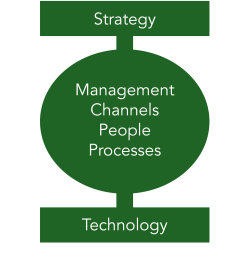How to beat the competition


Do you know how to beat the competition? Occasionally, all companies know, otherwise they wouldn't have sales. And systematically? If you could do this, it would certainly boost your company's growth.
Beating the competition systematically doesn't mean winning every time, but it does mean winning in the majority of cases where there is alignment between your offer and what the client is looking for.
Three stories
A few years ago, one of my partners in a multinational consulting firm told me that the best way to beat the competition was to have no competition. I asked him how it was possible, and he told me that he planned with the client's CEO which strategic initiatives should be carried out and then became responsible for executing those that fell within his sphere of competence. So I asked him if he always did that and he told me no, he was able to do it only in some cases.
In the 1990s, when I completed a postgraduate course in management, I took part in a group work to define the marketing mix (4 P) for a fast-moving consumer products company. When we discussed the P of price, the managing director of a Portuguese company in the same sector, who also took part in this group work, said that he always beat the competition by practicing the lowest price. This generated some discussion and he admitted that he didn't always win, but it influenced the outcome of our work.
More recently, in a conversation with a partner in a law firm, as part of a growth consultancy work provided by my company, I asked him why his team's hourly rate was higher than that of the other partners’ teams. He replied that he did not make proposals, he only concluded contracts. I asked if it had always been like this and he said no, only after many years and after having built a unique reputation. I also asked if it was always like this and he admitted that there were some exceptions.
These stories illustrate extreme and rare positions, most companies – even in the cases described above – don't have systematic solutions to beat the competition.
Four types of competitor
Strictly speaking, it's impossible not to have competition. Any sales opportunity has four types of competitor:

"Another company" is a traditional competitor that has a product and service offering similar to our company’s. A sales opportunity can have several competitors of this type.
"Doing nothing" is a fearsome competitor. It means that the client chooses not to buy our offer nor that of other companies, for various reasons that can range from budget constraints to insufficient value perceived by the client or lack of consensus among the team of buyers.
"Doing another thing" is also a fearsome competitor. It means that the client chooses to buy something different to satisfy other needs, and it can also be for various reasons such as in the "Doing nothing" type of competitor.
"Using internal resources" is a fearsome and dangerous competitor. It means that the client chooses to use their own resources to satisfy the needs that could be satisfied by our offer. It is a dangerous type of competitor because it can damage the relationship of mutual trust between us and the client for a long time, as the client may have taken advantage of information previously shared by us.
How can we fight these competitors? There are no "silver bullets", but it is a good principle to remember the basic requirement for selling: the client must have a surplus value, i.e. the client's perceived use value must be higher than the price the client has to pay.
Having this basic requirement in mind is not enough, we need to act accordingly by characterizing the use value for the client, preferably quantified.
It's often said that you can't quantify the use value for the client, whether they're an individual or a company. It's certainly difficult, otherwise everyone would do it, but it's not impossible. Sometimes we need to use indirect methods, for example using studies or previous client experiences.
An insurance company can use examples of loss recovery in the event of a fire or treatment in the event of illness or accident. A law firm can use examples of amounts negotiated in the acquisition of companies. A food company can quantify the physiological benefits of consuming its products. A media agency can characterize the increase in sales resulting from marketing campaigns.
"Doing nothing", "Doing another thing" and "Using internal resources" have a perceived use value and a price perceived by the client, just like any proposal of "Another company" and our own proposal. If we can demonstrate that the value-price ratio of our proposal is superior to that of all the other alternatives, then we are well positioned to win.
A methodology
Having value as the guideline for all company activity, we need to have the right approach to systematically beat the competition. To do this, all we have to do is to apply the FI growth methodology.

The FI growth methodology has 6 pillars:
- Strategy: it’s a business enabler that contains the definitions of the growth strategy components: what is the company's culture, what offers to sell to which clients, through which direct and intermediated channels (physical and digital), with what prices and with what distinctive brands.
- Management: it’s a business cycle that is repeated annually in the pursuit of growth: making the sales and marketing plans, budgeting revenues and costs, monitoring and analyzing performance, communicating internally and externally, celebrating successes, management results, making adjustments and learning from experience.
- Channels: it’s a business cycle that is repeated annually in the pursuit of growth: making the territorial plan to dimension each channel, establishing distribution contracts with intermediaries or building physical and digital means for direct channels, enabling them to sell, setting annual sales targets, monitoring and supporting the intermediaries’ activity, remunerating according to results, reviewing the category of each intermediary according to its evolution and learning from experience.
- People: it’s a business cycle that is repeated annually in the pursuit of growth: making the territorial plan to dimension the sales team (global and for each channel), recruiting, training and setting objectives for each person, coaching continuously, compensating according to results, promoting and learning from experience.
- Processes: it’s a business cycle that is repeated continuously in the pursuit of growth: planning in detail the marketing and sales campaigns of each channel, planning how to communicate with clients, carrying out communication campaigns to captivate clients, welcoming clients and selecting sales opportunities, persuading clients to buy, negotiating and closing sales, retaining clients and learning from experience.
- Technology: it’s a business enabler that contains the resources needed to carry out the activities of the business cycles: operational systems for employees, clients and partners, reporting systems, analytic and predictive systems and productivity tools.
In short, the FI growth methodology covers all the activities necessary for your company to grow sustainably.
Conclusion
To beat the competition, it is essential to always bear in mind the value for the client, to remember that it is impossible not to have competition, even if the client doesn't talk to any other company, to shape our proposal in such a way as to be better than the four types of competitor mentioned above and to use the FI growth methodology.
Now that you know how to beat the competition, apply it every day to boost your company's growth.
Filipe Simões de Almeida
Managing Partner, Fi Consulting
Published on 10-Oct-2023
